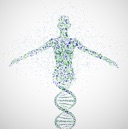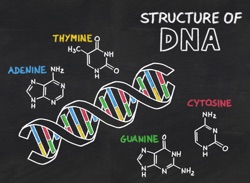 Students store Introductory Biology topics in ‘bubbles’, often unrelated to each other or the world the students inhabit. One challenging area where this happens a lot is mutation–how mutations happen, why mutations have consequences, and even the idea that mutations happen to ‘us.’ One of my favorite articles from the popular press had a title similar to “Blue eyes arose through human ‘mutation’ thousands of years ago”, with the word mutation offset in quotes–to indicate blue eye changes aren’t real mutations? In trying to make the concept more concrete and interesting to students, I’ve accumulated a series of human phenotypes (and primary literature sources) that amuse students while also driving key concepts home. The role of mutation in generating diversity and driving evolution is quietly but steadily made as well.
Students store Introductory Biology topics in ‘bubbles’, often unrelated to each other or the world the students inhabit. One challenging area where this happens a lot is mutation–how mutations happen, why mutations have consequences, and even the idea that mutations happen to ‘us.’ One of my favorite articles from the popular press had a title similar to “Blue eyes arose through human ‘mutation’ thousands of years ago”, with the word mutation offset in quotes–to indicate blue eye changes aren’t real mutations? In trying to make the concept more concrete and interesting to students, I’ve accumulated a series of human phenotypes (and primary literature sources) that amuse students while also driving key concepts home. The role of mutation in generating diversity and driving evolution is quietly but steadily made as well.
DNA
Teaching basepairing: consequences, applications
 Everyone teaches something about basepairing in Introductory Biology, but sometimes it’s just in passing, with no greater emphasis than the diversity of sugar variants receives. But basepairing is the wellspring of life itself and lies at the heart of each of the major informational transactions (DNA replication, transcription, translation) as well as a diversity of more recently-discovered processes in regulation. More and more, we’re also seeing it as the great keystone of new therapies. What are the core concepts and how can we teach basepairing in order to showcase all of these aspects?
Everyone teaches something about basepairing in Introductory Biology, but sometimes it’s just in passing, with no greater emphasis than the diversity of sugar variants receives. But basepairing is the wellspring of life itself and lies at the heart of each of the major informational transactions (DNA replication, transcription, translation) as well as a diversity of more recently-discovered processes in regulation. More and more, we’re also seeing it as the great keystone of new therapies. What are the core concepts and how can we teach basepairing in order to showcase all of these aspects?
Book review: the Eighth Day of Creation
Horace Judson’s “The Eighth Day of Creation” (only available used, to my knowledge, but worth every penny and who cares if your copy is a little tattered) was a foundational book for me in the path that lead to my career. It makes fascinating reading for anyone interested in how science actually takes place–conversations, inspirations, blind alleys, discovery. A brief book review follows.
What’s important about… biology’s Central Dogma?
‘What to teach’ in Introductory Biology presents a whole host of conundrums. Is our role to cover the breadth of all of biology (or all of the biology student will hear again in upper divisions) at breakneck pace and without depth? A whirlwind tour of vocabulary to commit to memory with vague understanding for some later date? I will argue periodically that we should pick a limited, integrated fraction of possible content and teach it in a way that allows students to see and grasp underlying concepts and universal themes, thereby enabling them to figure out what comes later, and to embark on their own to investigate whatever catches their fancy.
The key ideas of biology’s Central Dogma–or better put, the flow of information— are a critical case in point. We all agree that ‘something’ about DNA, RNA and protein is among our core duties. But what? My view is that identifying the roles of each of these players, how their structures fit them to play those roles, how they came to occupy and the ‘flow’ between them them are straightforward, core ideas in biology.
What’s important about… molecules of the Central Dogma?
 I think we’re focusing on the wrong thing when we follow classical textbook approaches to ‘Biomolecules’ and their categories (DNA, RNA, protein, carbs, lipids). I don’t have much to say about the latter two, but there are some Big Ideas about the molecules of the central dogma that I believe get lost in the tedium of -OH groups and dehydration reactions… I’ll discuss order of presentation and such later; now I want to talk about monomer structure. To wit: How are (the group nucleic acid monomers) and (the group amino acids) all similar, and why must this be so?
I think we’re focusing on the wrong thing when we follow classical textbook approaches to ‘Biomolecules’ and their categories (DNA, RNA, protein, carbs, lipids). I don’t have much to say about the latter two, but there are some Big Ideas about the molecules of the central dogma that I believe get lost in the tedium of -OH groups and dehydration reactions… I’ll discuss order of presentation and such later; now I want to talk about monomer structure. To wit: How are (the group nucleic acid monomers) and (the group amino acids) all similar, and why must this be so?
What’s important about… teaching DNA?
 Everybody agrees that we should teach the ‘Central Dogma’ in IntroBio (DNA => RNA => Protein). But surely that’s not an answer to the question. What is important to understand about the actors and the ‘flow of information’ [what’s information?], why does each actor have the role it has, why are the actors chemically as they are and not otherwise (to paraphrase Einstein). As part of this blog, I’m going to go through views I’ve developed over two decades, starting with DNA. Foreshadowing: it’s not going to be about alphabets: the letters D-N-A and the letters A-G-C-T cannot encompass what is important about a molecule capable of holding in its structure the instructions-to-build for every known living thing.
Everybody agrees that we should teach the ‘Central Dogma’ in IntroBio (DNA => RNA => Protein). But surely that’s not an answer to the question. What is important to understand about the actors and the ‘flow of information’ [what’s information?], why does each actor have the role it has, why are the actors chemically as they are and not otherwise (to paraphrase Einstein). As part of this blog, I’m going to go through views I’ve developed over two decades, starting with DNA. Foreshadowing: it’s not going to be about alphabets: the letters D-N-A and the letters A-G-C-T cannot encompass what is important about a molecule capable of holding in its structure the instructions-to-build for every known living thing.
